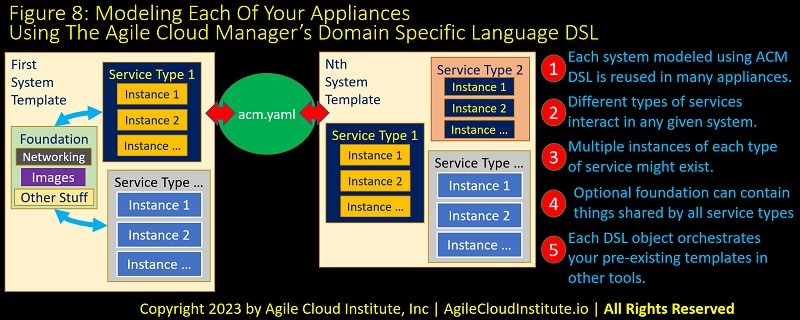Architecting the Agile Enterprise with the Agile Cloud Manager
Part 8 of 16: Modeling Each Of Your Appliances Using The Agile Cloud Manager’s Domain Specific Language DSL
Figure 8 illustrates the simple, yet powerful, Domain Specific Language DSL offered by the Agile Cloud Manager.

This DSL enables you to model each of your systems and appliances based on how your unique business operates.
As you can see in Figure 8, each system can be modeled as a collection of some number of types of different services which might interact within the system. Multiple instances of each type of service might exist. An optional foundation can also be defined to provide items shared by all the different service types, such as networking, images, and other things.
You can continue to use your pre-existing templates from other tools because the Agile Cloud Manager’s Domain Specific Language DSL simply orchestrates your pre-existing templates in a way that enables you to deliver appliances more efficiently into enterprise-level pipelines.
Figure 8 also illustrates how one acm.yaml file summarizes several different systems, which are each defined in their own separate system configuration file.
Figure 8 is like taking apart a toaster to see that there are a few major subcomponents within each toaster, with each subcomponent abstracting away the complexity of deeper levels.
Figure 8 also shows how each system configuration can look very much like any other system configuration because the Domain Specific Language DSL offered by the Agile Cloud Manager enables you to organize your systems in a way that is most relevant to your business.
Technical details of the underlying third-party templates and cloud providers are abstracted away by the Agile Cloud Manager’s system templates, so that you can organize all your systems in terms of the value that each system provides for your unique business.
back to Site Home
back to Architecture section Home
Back to Part 7 of 16